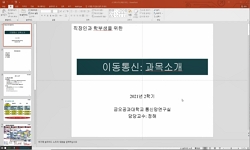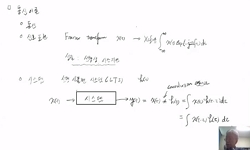Coded cooperation that integrates channel coding in cooperative transmission has gained a great deal of interest in wireless relay networks. The performance analysis of coded cooperation protocol with multiple relays is investigated in this paper. We ...
http://chineseinput.net/에서 pinyin(병음)방식으로 중국어를 변환할 수 있습니다.
변환된 중국어를 복사하여 사용하시면 됩니다.
- 中文 을 입력하시려면 zhongwen을 입력하시고 space를누르시면됩니다.
- 北京 을 입력하시려면 beijing을 입력하시고 space를 누르시면 됩니다.


Performance Analysis of Coded Cooperation Protocol with Reactive and Proactive Relay Selection
한글로보기https://www.riss.kr/link?id=A107909464
-
저자
Asaduzzaman (울산대학교) ; Hyung-Yun Kong
- 발행기관
- 학술지명
- 권호사항
-
발행연도
2011
-
작성언어
English
- 주제어
-
등재정보
KCI등재,SCOPUS
-
자료형태
학술저널
-
수록면
133-142(10쪽)
-
KCI 피인용횟수
0
-
비고
학회 요청에 의해 무료로 제공
- 제공처
- 소장기관
-
0
상세조회 -
0
다운로드
부가정보
다국어 초록 (Multilingual Abstract)
Coded cooperation that integrates channel coding in cooperative transmission has gained a great deal of interest in wireless relay networks. The performance analysis of coded cooperation protocol with multiple relays is investigated in this paper. We show that the diversity order achieved by the coded cooperation in a multi-relay wireless network is not only dependent on the number of cooperating relays but is also dependent on the code-rate of the system. We derive the code-rate bound, which is required to achieve the full diversity gain of the order of cooperating nodes. The code-rate required to achieve full diversity is a linearly decreasing function of the number of available relays in the network. We show that the instantaneous channel state information (CSI)-based relay selection can effectively alleviate this code-rate bound. Analysis shows that the coded cooperation with instantaneous CSI-based relay selection can achieve the full diversity, for an arbitrary number of relays, with a fixed code-rate. Finally, we develop tight upper bounds for the bit error rate (BER) and frame error rate (FER) of the relay selection based on coded cooperation under a Rayleigh fading environment. The analytical upper bounds are verified with simulation results.
목차 (Table of Contents)
- Abstract
- Ⅰ. Introduction
- Ⅱ. System Model
- Ⅲ. Performance Analysis
- Ⅳ. Numerical Results
- Abstract
- Ⅰ. Introduction
- Ⅱ. System Model
- Ⅲ. Performance Analysis
- Ⅳ. Numerical Results
- Ⅴ. Conclusion
- Appendix A
- References
참고문헌 (Reference)
1 E. Beres, "Selection cooperation in multisource cooperative networks" 7 (7): 118-127, 2008
2 J. Hagenauer, "Rate-compatible punctured convolutional codes(RCPC codes)and their applications" 36 (36): 389-400, 1988
3 A. Papoulis, "Probability, Random Variables, and Stochastic Processes, 4th Ed" McGraw- Hill 2002
4 A. J. Viterbi, "Principles of Digital Communication and Coding, Communications and Information Theory" McGraw-Hill 1979
5 D. S. Michalopoulos, "Performance analysis of single relay selection in Rayleigh fading" 7 (7): 3718-3724, 2008
6 A. Tajer, "Opportunistic cooperation via relay selection with minimal information exchange" 1926-1930, 2007
7 R. Knopp, "On coding for block fading channels" 46 (46): 189-205, 2000
8 E. Malkamaki, "Evaluating the performance of convolutional codes over block fading channels" 45 (45): 1643-1646, 1999
9 T. E. Hunter, "Diversity through coded cooperation" 5 (5): 283-289, 2006
10 J. N. Laneman, "Distributed space-timecoded protocols for exploiting cooperative diversity in wireless networks" 49 (49): 2415-2425, 2003
1 E. Beres, "Selection cooperation in multisource cooperative networks" 7 (7): 118-127, 2008
2 J. Hagenauer, "Rate-compatible punctured convolutional codes(RCPC codes)and their applications" 36 (36): 389-400, 1988
3 A. Papoulis, "Probability, Random Variables, and Stochastic Processes, 4th Ed" McGraw- Hill 2002
4 A. J. Viterbi, "Principles of Digital Communication and Coding, Communications and Information Theory" McGraw-Hill 1979
5 D. S. Michalopoulos, "Performance analysis of single relay selection in Rayleigh fading" 7 (7): 3718-3724, 2008
6 A. Tajer, "Opportunistic cooperation via relay selection with minimal information exchange" 1926-1930, 2007
7 R. Knopp, "On coding for block fading channels" 46 (46): 189-205, 2000
8 E. Malkamaki, "Evaluating the performance of convolutional codes over block fading channels" 45 (45): 1643-1646, 1999
9 T. E. Hunter, "Diversity through coded cooperation" 5 (5): 283-289, 2006
10 J. N. Laneman, "Distributed space-timecoded protocols for exploiting cooperative diversity in wireless networks" 49 (49): 2415-2425, 2003
11 M. K. Simon, "Digital Communication over Fading Channels, 2nd Ed., Wiley Series in Telecommunications and Signal Processing" John Wiley & Sons 2005
12 J. N. Laneman, "Cooperative diversity in wireless networks:Efficient protocols and outage behavior" 5 (5): 3062-3080, 2004
13 A. Bletsas, "Cooperative communications with outage-optimal opportunistic relaying" 6 (6): 3450-3460, 2007
14 A. Stefanov, "Cooperative coding for wireless networks" 52 (52): 1470-1476, 2004
15 공형윤, "Coded Diversity for Cooperative MISO Based Wireless Sensor Networks" IEEE-INST ELECTRICAL ELECTRONICS ENGINEERS INC 13 (13): 516-518, 200907
16 I. Krikidis, "Amplify-and-forward with partial relay selection" 12 (12): 235-237, 2008
17 A. Bletsas, "A simple cooperative diversity method based on network path selection" 24 (24): 659-672, 2006
18 J. W. Craig, "A new, simple and exact result for calculating the probability of error for two-dimensional signal constellations" 571-575, 1991
동일학술지(권/호) 다른 논문
-
Network Modeling and Circuit Characteristics of Aperture-Coupled Vertically Mounted Strip Antenna
- 한국전자파학회JEES
- Jeong Phill Kim
- 2011
- KCI등재,SCOPUS
-
- 한국전자파학회JEES
- Hye-Min Lee
- 2011
- KCI등재,SCOPUS
-
Design of a Planar Slotted Waveguide Array Antenna for X-band Radar Applications
- 한국전자파학회JEES
- Rashid Ahmad Bhatti
- 2011
- KCI등재,SCOPUS
-
A Lock-Time Improvement for an X-Band Frequency Synthesizer Using an Active Fast-Lock Loop Filter
- 한국전자파학회JEES
- Yun-Seong Heo
- 2011
- KCI등재,SCOPUS
분석정보
인용정보 인용지수 설명보기
학술지 이력
| 연월일 | 이력구분 | 이력상세 | 등재구분 |
|---|---|---|---|
| 2023 | 평가예정 | 해외DB학술지평가 신청대상 (해외등재 학술지 평가) | |
| 2020-01-01 | 평가 | 등재학술지 유지 (해외등재 학술지 평가) |  |
| 2013-01-01 | 평가 | 등재 1차 FAIL (등재유지) |  |
| 2012-06-22 | 학술지명변경 | 한글명 : Journal of The Korean Institute of Electromagnetic Engineering and Science -> Journal of Electromagnetic Engineering and Science외국어명 : Journal of The Korean Institute of Electromagnetic Engineering and Science -> Journal of Electromagnetic Engineering and Science |  |
| 2010-01-01 | 평가 | 등재학술지 유지 (등재유지) |  |
| 2008-04-08 | 학술지명변경 | 한글명 : Journal of The Korea Electromagnetic Engineering Society -> Journal of The Korean Institute of Electromagnetic Engineering and Science외국어명 : Journal of The Korea Electromagnetic Engineering Society -> Journal of The Korean Institute of Electromagnetic Engineering and Science |  |
| 2007-01-01 | 평가 | 등재학술지 선정 (등재후보2차) |  |
| 2006-01-01 | 평가 | 등재후보 1차 PASS (등재후보1차) |  |
| 2005-09-28 | 학술지명변경 | 한글명 : 영문논문지(JKEES) -> Journal of The Korea Electromagnetic Engineering Society |  |
| 2004-01-01 | 평가 | 등재후보학술지 선정 (신규평가) |  |
학술지 인용정보
| 기준연도 | WOS-KCI 통합IF(2년) | KCIF(2년) | KCIF(3년) |
|---|---|---|---|
| 2016 | 0.28 | 0.28 | 0.31 |
| KCIF(4년) | KCIF(5년) | 중심성지수(3년) | 즉시성지수 |
| 0.24 | 0.21 | 0.656 | 0.03 |




 DBpia
DBpia




